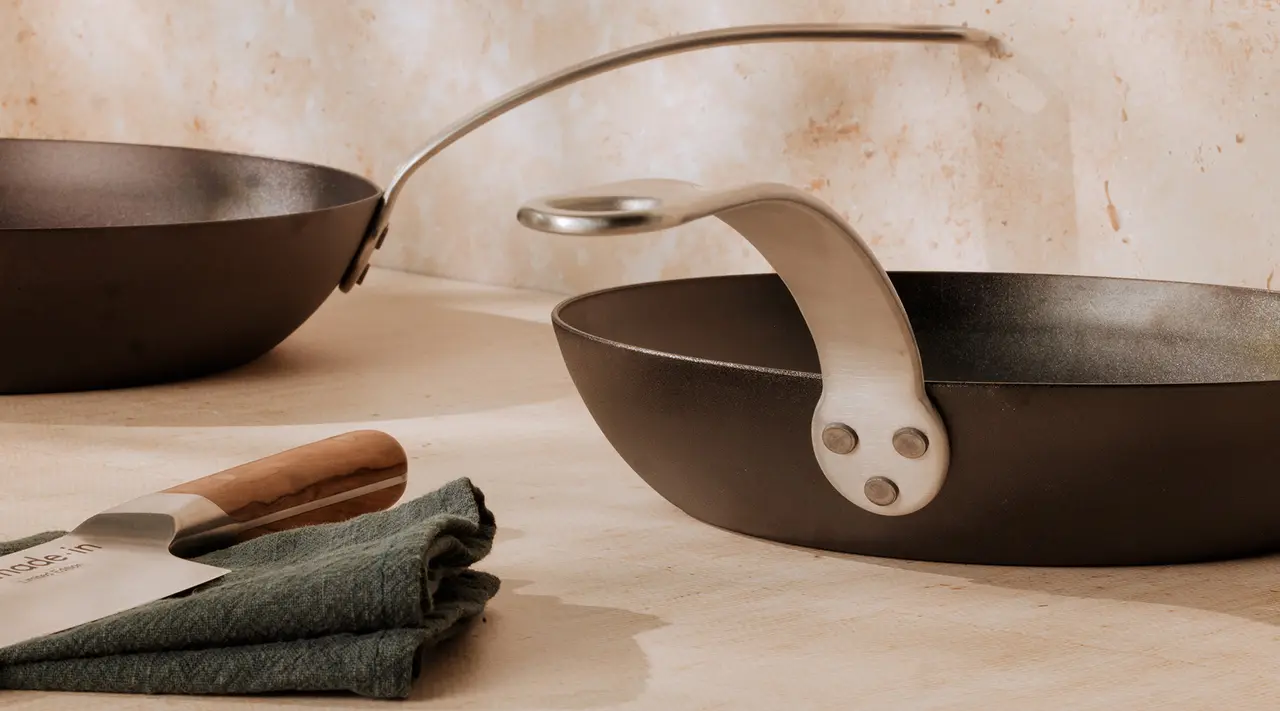High-quality cookware forms the backbone of our cooking routine. We’re not talking about high-tech blenders or smart ovens: rather, we’re talking about solid, versatile, and built-to-last pieces that you don’t need a manual to use.
One prime example is the carbon steel pan. In this post, we’ll explain exactly why carbon steel makes for such an excellent frying pan—and why it’s worth a spot in your cupboard.
Why Is Carbon Steel the Best Choice for Your Kitchen?

Carbon steel cookware offers many of the benefits of your favorite cast iron skillet, but in a less bulky package that weighs just slightly more than stainless steel. From its excellent heat control to its versatile design, here are some of carbon steel’s biggest selling points.
Superior Heat Conductivity
Because of its excellent heat retention and non stick properties, carbon steel cookware is often compared to cast iron. Yet the two differ in a couple of key ways:
- While cast iron might fare slightly better in terms of heat retention, carbon steel is much more responsive to changes in temperature, meaning carbon steel is quicker to heat up and cool down to avoid overcooking your steak or burning your butter.
- Carbon steel distributes heat throughout the cooking surface area better than cast iron, making for better sears and more even browning without the possibility of hot or cold spots.
Versatility and Durability
Carbon steel cookware is often described as being virtually indestructible—and it’s true that it’s almost impossible to permanently ruin your pan (save from steamrolling it). Ours is safe up to 1200F, so feel free to place it over a live fire, on the grill, or even in a pizza oven and your pan will emerge unscathed (even if there’s a flare-up).
With that said, proper care and maintenance go a long way in keeping your pan in peak condition. You should always make sure to hand wash and carefully dry your pan after using it, keeping it far away from the dishwasher. Carbon steel is a reactive material—same as cast iron—meaning you should also avoid cooking acidic foods for long periods of time in your carbon steel pan (though you can just reseason after the fact).
Check out our guide to carbon steel maintenance to learn more about caring for this material, including how-tos on stripping and reseasoning.
Light Weight and Maneuverability
Like we mentioned, carbon steel offers most of the benefits of cast iron, but with a much lighter profile. This makes it significantly easier to flip and toss ingredients, as well as move your pan on and off the stove (or from kitchen to campsite).
For reference, our 10” Seasoned Carbon Steel Frying Pan weighs in at 3 pounds—less than three-quarters of a pound more than our 10” Stainless Clad Frying Pan (at 2.25 pounds). Compare that with our 11" Enameled Cast Iron Skillet, which weighs in at 5.8 pounds.
Factors to Consider When Choosing the Best Carbon Steel Pan

Before you hit purchase on a new carbon steel pan, you’ll want to make sure you’re getting the right model and size for your needs—here’s some of the factors to consider.
Size
It’s important to be realistic when choosing the size of your new pan. How much storage space do you actually have, and how many people do you typically cook for? If your pan is too large or too small (or even just too big to haul out on a regular basis), you’re probably not going to use it very often.
That’s why we made our Seasoned Carbon Steel Frying Pan in 8", 10”, and 12” options, so you can choose the best size for your needs.
Seasoning
Like cast iron pans, carbon steel pans are often available to purchase in either preseasoned or unseasoned versions. You might choose the preseasoned option if you’re not picky about your seasoning, or if you’re looking to avoid an extra step. For those who prefer to control the thickness or consistency of their seasoning, an unseasoned version is probably the better choice.
Thickness and Construction
Carbon steel pans typically have a slimmer build than cast iron skillets (our 10” Carbon Steel Pan is 37% thinner than a Lodge cast iron skillet of the same size, for example) but it’s still thick enough to provide excellent heat retention and high heat tolerance, without being flimsy or being easily susceptible to damage. You'll want a pan that can hold up to high heat without being too thick and unwieldy or too thin and easily damaged—there's a happy medium to be found.
What’s the Best Carbon Steel Pan?
Our Carbon Steel Frying Pan is a great option for those new to carbon steel and connoisseurs alike. Made from a single sheet of annealed carbon steel (an alloy composed of 99% iron and 1% carbon) with pre-applied seasoning layers, these pans offer fantastic durability and performance at an affordable price point. They’re also fairly easy to clean and maintain—especially once they’ve built up a non stick patina.
Ready to Shop?
Versatile, long-lasting, and able to handle all your favorite recipes, carbon steel cookware has a permanent place in our cookware collection. If you haven’t added one to your collection yet, we hope we’ve managed to convince you—though this coffee-crusted filet mignon might do the trick, as well.

























